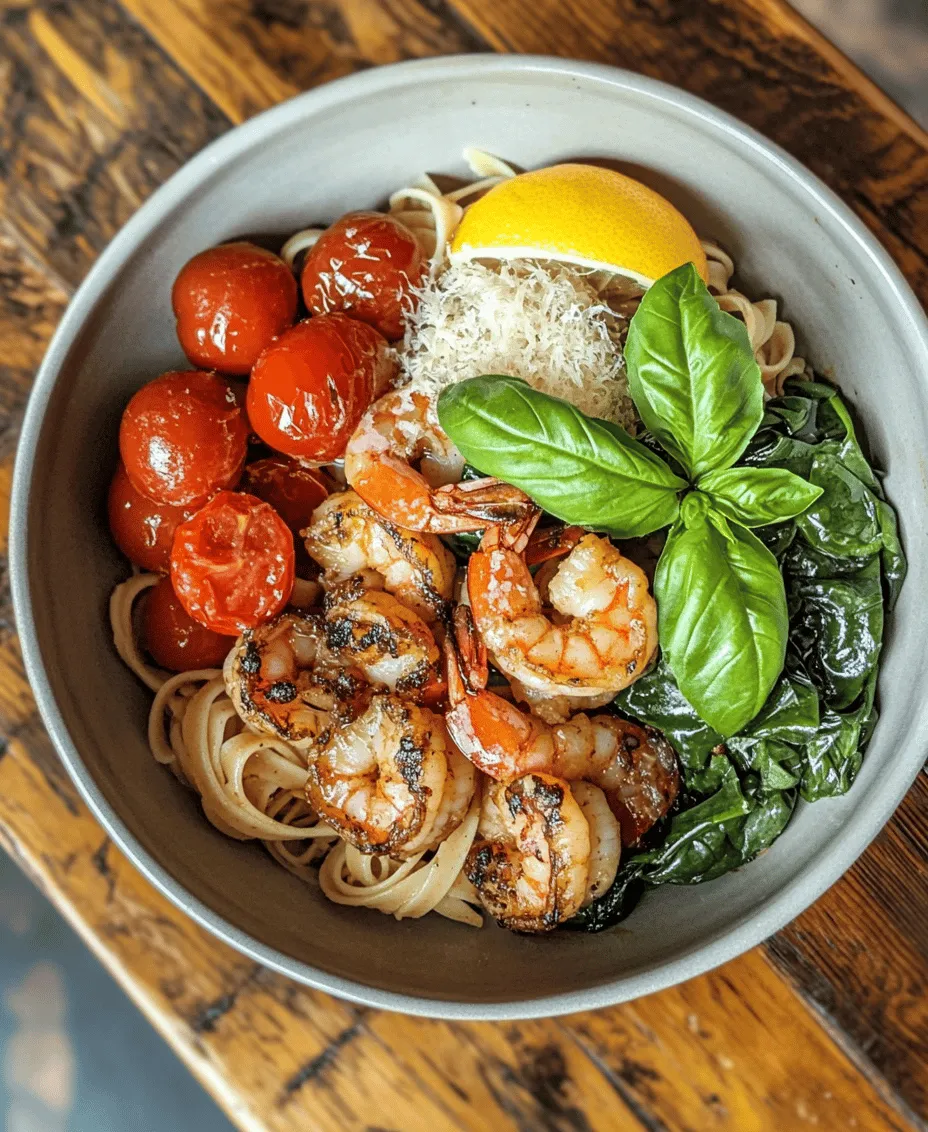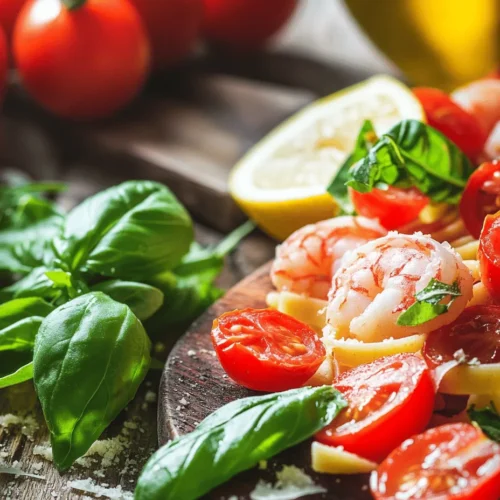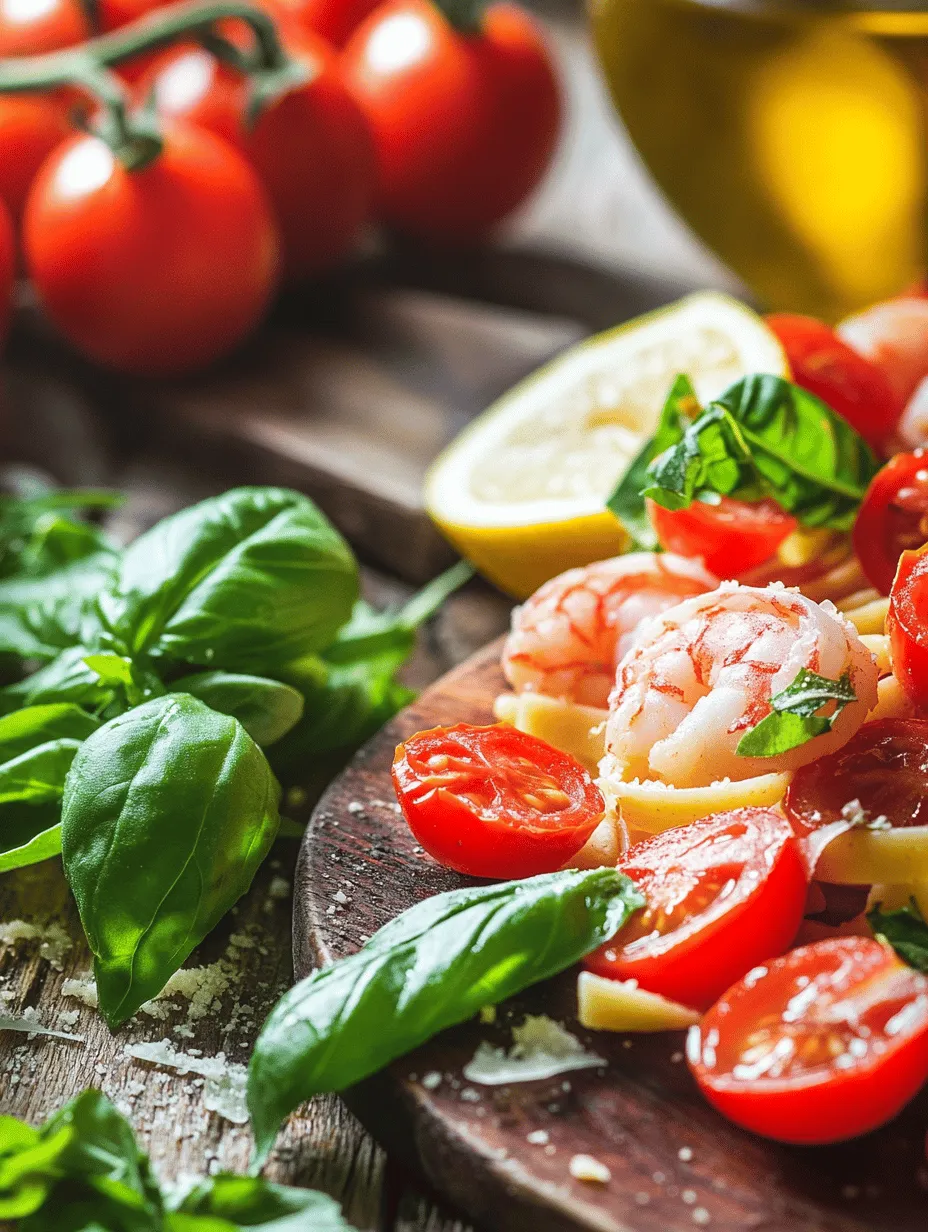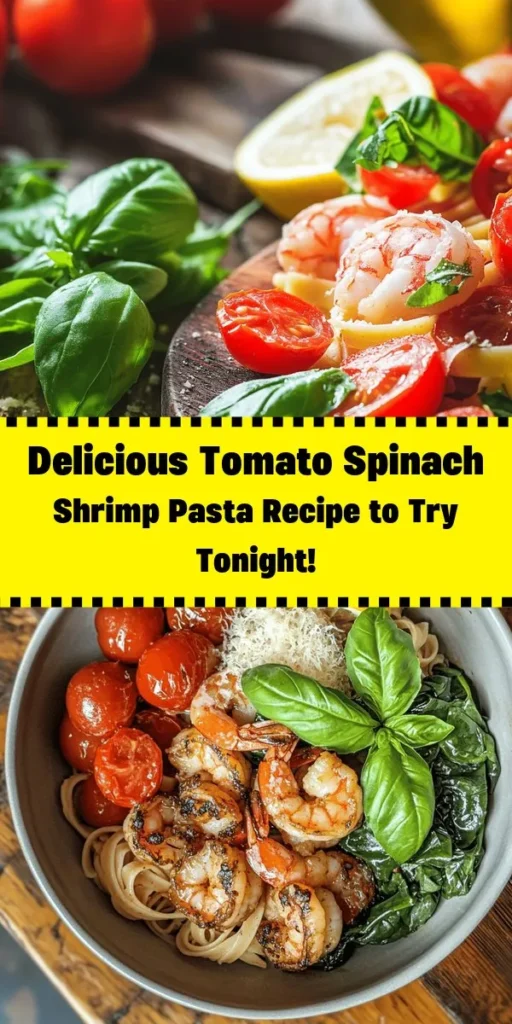Introduction
If you’re on the hunt for a vibrant and flavorful meal that bursts with nutrition, look no further than Tomato Spinach Shrimp Pasta. This dish is not only visually appealing with its bright colors but also offers a delightful combination of tastes and textures that make it a family favorite. The succulent shrimp, tender spinach, and juicy cherry tomatoes harmonize beautifully with the pasta, creating a dish that is both satisfying and healthy.
What sets this recipe apart is the emphasis on fresh ingredients. Using high-quality, seasonal produce not only elevates the dish’s flavor but also enhances its health benefits. Fresh ingredients are essential in any culinary creation, and this Tomato Spinach Shrimp Pasta is no exception. The vibrant greens, succulent seafood, and sweet tomatoes come together to create a meal that nourishes the body and pleases the palate.
In this article, you can expect a comprehensive guide to making Tomato Spinach Shrimp Pasta, complete with step-by-step instructions, insights into ingredient selection, and serving suggestions. Whether you’re an experienced cook or a kitchen novice, this recipe will empower you to create a dish that impresses at the dinner table.
Understanding the Ingredients
Pasta Choices: Linguine vs. Spaghetti
When it comes to selecting the perfect pasta for your Tomato Spinach Shrimp Pasta, you may find yourself torn between two popular options: linguine and spaghetti. Both types of pasta are delicious, but they each offer unique textures and flavor profiles that can affect the overall dish.
Linguine is a flat, wide noodle that resembles fettuccine but is thinner. Its shape allows it to hold onto sauces exceptionally well, making it a fantastic choice for this recipe. The broader surface area of linguine provides a delightful mouthfeel when paired with the light sauce created from the sautéed garlic, tomatoes, and spinach.
On the other hand, spaghetti is a long, round noodle that is universally recognized and loved. It has a firmer texture that can also work well in this dish. If you prefer a bit more bite in your pasta, spaghetti might be the right choice for you.
Ultimately, the decision between linguine and spaghetti boils down to personal preference. Feel free to experiment with both types to discover which one you enjoy most in this vibrant dish.
Shrimp: A Protein Powerhouse
Shrimp is the star protein in this Tomato Spinach Shrimp Pasta, and for good reason. Not only is shrimp incredibly delicious, but it is also a nutritional powerhouse. Packed with protein, low in calories, and rich in essential vitamins and minerals, shrimp makes for a healthy addition to any meal.
One of the standout benefits of shrimp is its high protein content, which is vital for muscle repair and growth. A serving of shrimp can provide a significant portion of your daily protein needs without the added fat found in other protein sources. Moreover, shrimp is an excellent source of selenium, vitamin B12, and iodine, which are essential for maintaining a healthy metabolism and supporting overall health.
When selecting shrimp for your pasta dish, aim for fresh or sustainably sourced shrimp. Look for shrimp that are firm to the touch, have a mild ocean scent, and are free from any discoloration. If you choose frozen shrimp, ensure they are properly thawed before cooking. Proper storage is crucial; keep shrimp refrigerated and use them within a day or two of purchase for optimal freshness.
The Role of Spinach in the Dish
Spinach is not just a colorful addition to Tomato Spinach Shrimp Pasta; it also brings a wealth of health benefits to the table. This leafy green is loaded with essential vitamins and minerals, including vitamins A, C, and K, as well as iron and calcium. Incorporating spinach into your meals can support a healthy immune system, bone health, and skin vitality.
Beyond its nutritional benefits, spinach also adds a beautiful contrast of color to the dish, making it visually appealing. The tender leaves wilt perfectly when cooked, integrating seamlessly with the pasta and allowing the flavors of the garlic and tomatoes to infuse the greens.
When working with spinach, you can use fresh spinach leaves or frozen spinach. Fresh spinach will wilt down considerably when cooked, while frozen spinach may require extra draining to remove excess moisture. Either way, adding spinach to your pasta not only boosts its nutritional profile but also enhances the overall flavor and color of the dish.
Cherry Tomatoes: Sweetness and Texture
Tomatoes are a staple in many pasta dishes, but for this recipe, we recommend using fresh cherry tomatoes. These little gems are packed with flavor and provide a delightful sweetness that complements the savory shrimp and earthy spinach beautifully. Their juicy texture contrasts perfectly with the pasta, creating a delightful burst of flavor in every bite.
One of the main advantages of using fresh cherry tomatoes is their natural sweetness, which can elevate the dish without the need for added sugars. When roasted or sautéed, cherry tomatoes become even more flavorful, as the heat concentrates their natural sugars and enhances their sweetness.
If you’re tempted to use canned tomatoes in a pinch, you can do so, but fresh cherry tomatoes will undoubtedly yield a fresher taste and superior texture. Look for tomatoes that are brightly colored, firm to the touch, and free from blemishes.
Essential Aromatics: Garlic and Herbs
No pasta dish is complete without the aromatic flavors of garlic and herbs. Garlic serves as the backbone of this Tomato Spinach Shrimp Pasta, providing a robust flavor that complements the other ingredients beautifully. When sautéed, garlic releases its essential oils, creating a fragrant base that enhances the overall dish.
In addition to garlic, fresh herbs play a crucial role in brightening up the flavors of the pasta. Basil is a classic pairing with tomatoes and seafood, adding a fresh, aromatic quality that elevates the dish. You can use fresh basil leaves, tearing them slightly to release their oils, or dried basil if fresh is not available.
Other herbs like parsley or oregano can also be incorporated for added depth of flavor. The key is to adjust the amount of herbs to your taste preferences, ensuring that they enhance rather than overpower the dish.
Step-by-Step Guide to Making Tomato Spinach Shrimp Pasta
Cooking the Pasta
The first step in creating your Tomato Spinach Shrimp Pasta is cooking the pasta. Start by bringing a large pot of salted water to a rolling boil. The salt is essential, as it adds flavor to the pasta during cooking. Once the water is boiling, add your chosen pasta—linguine or spaghetti—and cook according to the package instructions until al dente.
Al dente pasta is slightly firm to the bite, providing the perfect texture to balance the tender shrimp and cooked vegetables. Remember to stir the pasta occasionally to prevent it from sticking together. Once cooked, reserve about a cup of the pasta cooking water for later use, then drain the pasta in a colander. Do not rinse the pasta, as this will wash away the starch that helps the sauce adhere to the noodles.
After draining, toss the pasta with a drizzle of olive oil to prevent it from clumping together. Set it aside while you prepare the rest of the dish.
This initial step sets the foundation for your Tomato Spinach Shrimp Pasta, ensuring that the pasta’s texture and flavor will complement the other vibrant ingredients in this delicious meal. With the pasta cooking away, let’s move on to the next steps in crafting this delightful dish.

When it comes to a delightful, nutritious meal that can be prepared quickly, few dishes can compete with Tomato Spinach Shrimp Pasta. This vibrant dish not only tantalizes the taste buds but also packs a nutritional punch, making it a go-to recipe for any home cook looking to impress. Below, we delve into the detailed instructions for achieving the perfect al dente pasta, sautéing shrimp to perfection, creating a rich sauce, and combining all the elements for a stunning presentation.
Achieving Perfect Al Dente Pasta
Cooking pasta perfectly is an art form that can elevate your dish from good to great. To achieve al dente pasta, follow these steps:
1. Choose the Right Pasta: For this recipe, linguine or spaghetti works beautifully. Opt for high-quality dried pasta for the best texture.
2. Boil Water: Fill a large pot with water and add a generous amount of salt (about 1 tablespoon per quart of water). Bring to a rolling boil.
3. Cook the Pasta: Add the pasta to the boiling water and stir gently to prevent sticking. Refer to the package instructions for cooking time, but start checking for doneness one to two minutes before the suggested time.
4. Test for Al Dente: To check for doneness, take a piece of pasta out and bite into it. It should be cooked through but still firm to the bite, with a slight chew.
5. Reserve Pasta Water: Before draining the pasta, reserve about one cup of the starchy cooking water. This water can be used to adjust the sauce’s consistency later, giving it a silky texture and helping the sauce adhere to the pasta.
Sautéing the Shrimp
Cooking shrimp is straightforward, but timing and seasoning are crucial. Here’s how to sauté shrimp perfectly:
1. Preparation: Start with peeled and deveined shrimp, preferably large or jumbo for added texture. Pat them dry with a paper towel to ensure they sear rather than steam.
2. Seasoning: In a bowl, toss the shrimp with salt, pepper, and a pinch of red pepper flakes for a hint of heat. You can also add minced garlic or lemon zest for extra flavor.
3. Sautéing: Heat a tablespoon of olive oil in a large skillet over medium-high heat. Once the oil is shimmering, add the shrimp in a single layer, ensuring they are not overcrowded.
4. Cooking Time: Sauté the shrimp for about 2-3 minutes on one side until they turn pink and start to curl. Flip them and cook for another 1-2 minutes until fully cooked. Remove the shrimp from the skillet and set aside to prevent overcooking.
Creating the Sauce
The sauce is where the magic happens, filling your kitchen with inviting aromas. Follow these steps to prepare a flavorful sauce:
1. Sautéing Tomatoes: In the same skillet used for the shrimp, add a bit more olive oil if necessary. Lower the heat to medium and add chopped tomatoes (fresh or canned). Allow them to cook for 4-5 minutes, stirring occasionally, until they soften and start to release their juices.
2. Building Flavors: Add minced garlic and a pinch of salt to the tomatoes. Sauté for an additional minute until the garlic is fragrant. This step is crucial as it enhances the overall flavor profile of the sauce.
3. Deglazing the Pan: If there are brown bits stuck to the bottom of the skillet (from the shrimp), deglaze the pan by pouring in a splash of white wine or vegetable broth. Use a wooden spoon to scrape up those flavorful bits, incorporating them into the sauce. This step adds depth and richness to your dish.
4. Finishing the Sauce: After deglazing, let the sauce simmer for a few minutes until slightly thickened. Add a splash of lemon juice or a teaspoon of sugar to balance the acidity if needed.
Combining Ingredients
Bringing all elements together is where the dish truly comes alive:
1. Integrating the Spinach: Once your sauce is ready, stir in the fresh spinach. Allow it to wilt for just a minute, as overcooking can lead to a mushy texture.
2. Mixing in the Pasta: Add the drained pasta directly to the skillet with the sauce and spinach. Toss everything together gently, ensuring that the pasta is well-coated with the sauce.
3. Adjusting Consistency: If the sauce appears too thick, gradually add reserved pasta water a little at a time until you reach your desired consistency. The starch from the pasta water will help the sauce cling to the pasta beautifully.
Final Presentation and Serving Suggestions
Now that your Tomato Spinach Shrimp Pasta is complete, it’s time to serve it beautifully:
1. Garnishing: Transfer the pasta to serving plates or a large serving bowl. Garnish with freshly chopped parsley or basil for a pop of color. A sprinkle of grated Parmesan cheese adds a savory touch, but this can be omitted for a dairy-free option.
2. Serving Size: This recipe typically serves 4, making it perfect for family dinners or casual gatherings.
3. Pairing Suggestions: Consider serving this dish with a side salad featuring mixed greens and a light vinaigrette, or crusty garlic bread for dipping. A crisp white wine, such as Sauvignon Blanc, pairs wonderfully with the flavors of the dish.
Nutritional Information
This Tomato Spinach Shrimp Pasta is not only delicious but also nutritious. Here’s a breakdown of the nutritional content per serving (approximately):
– Calories: 450
– Protein: 30g
– Fats: 12g
– Carbohydrates: 60g
Dietary Considerations
– Gluten-Free Options: Substitute traditional pasta with gluten-free pasta made from rice or quinoa if gluten is a concern.
– Vegetarian Adaptations: For a vegetarian version, replace shrimp with sautéed mushrooms or chickpeas for added protein and texture.
Common Variations and Substitutions
Feel free to adapt this recipe based on your dietary needs or seasonal ingredients:
– Alternative Proteins: Chicken breast or tofu can be used instead of shrimp. For chicken, cut it into bite-sized pieces and sauté until fully cooked. For tofu, press to remove excess moisture, cube, and sauté until golden.
– Seasonal Variations: Incorporate seasonal vegetables such as zucchini, bell peppers, or asparagus for added nutrition and flavor.
– Herb Variations: Experiment with different fresh herbs like dill or thyme for varied flavor profiles.
Conclusion
Tomato Spinach Shrimp Pasta is a delightful dish that combines vibrant flavors, nutritional benefits, and ease of preparation. The balance of shrimp, spinach, and a rich tomato sauce creates a satisfying meal that can be enjoyed any night of the week. With its versatility and adaptability, this recipe invites creativity, allowing you to tailor it to your taste preferences and dietary needs. We encourage you to give this recipe a try and savor the wholesome flavors that make Tomato Spinach Shrimp Pasta a favorite at the dinner table. Enjoy the culinary journey!



